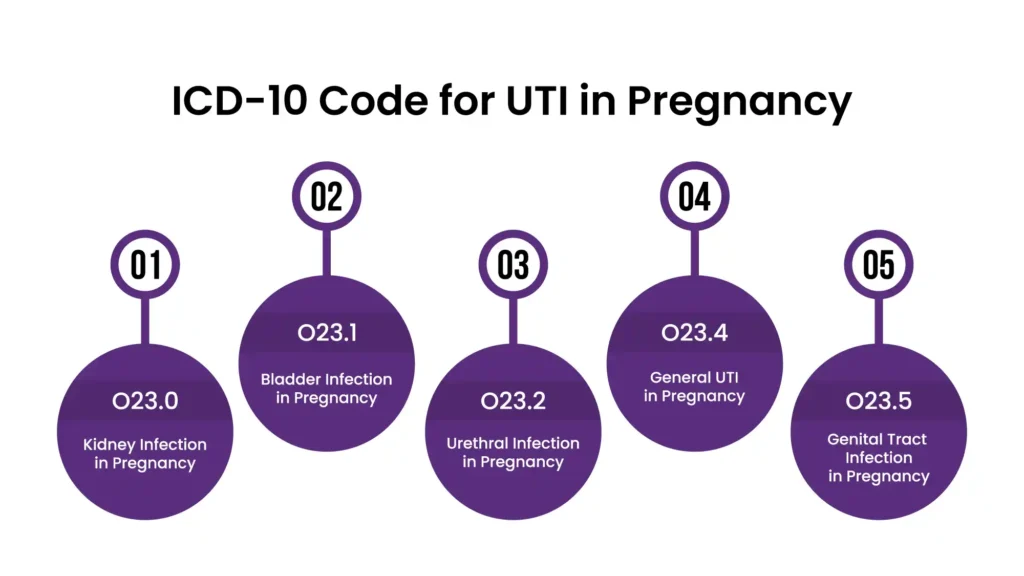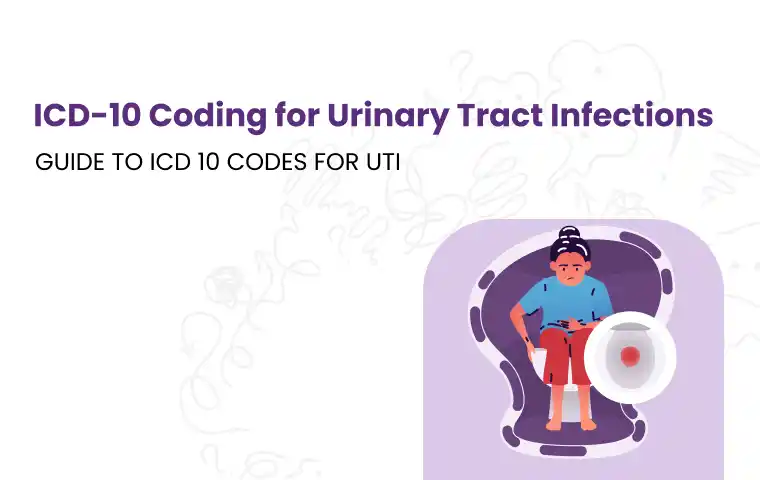)Urinary Tract Infections (UTIs) are among the most common conditions requiring medical attention worldwide. Accurate diagnosis and medical billing for UTIs rely heavily on the International Classification of Diseases, Tenth Revision (ICD-10). However, UTI ICD 10 codes can make your body sweating as they can be challenging due to the nuances involved in site specification, patient demographics, and associated conditions.
This post sheds light into the ICD-10 codes for UTIs, offering healthcare professionals, medical billers, and coders a valuable resource to ensure precision in documentation, compliance, and reimbursement. Whether you’re coding for an unspecified UTI, recurrent infections, or conditions involving specific pathogens, this guide covers it all.

What is the ICD-10 Code for UTI?
The general ICD-10 code for a Urinary Tract Infection (UTI), site not specified, is N39.0. This code is utilized when medical documentation lacks details about the specific part of the urinary system affected. Despite being a catch-all code, its correct application requires careful consideration to avoid reimbursement issues or claim rejections.
Key ICD-10 Codes for UTI Scenarios
- N39.0: Urinary Tract Infection, Site Not Specified
- When to use it: Initial diagnosis without specific details on the location (e.g., bladder, kidneys).
- Clinical scenarios: Primary care or urgent care settings where tests are pending or symptoms are general.
- Documentation tip: Whenever possible, specify the site to use a more accurate code.
- N30.00 – N30.01: Acute Cystitis
- N30.00: Acute cystitis without hematuria
- N30.01: Acute cystitis with hematuria
- When to use: If documentation specifies a bladder infection and notes the presence (or absence) of blood in the urine.
- Why it matters: Hematuria often indicates a more severe case, impacting treatment strategies and billing.
- N10: Acute Pyelonephritis
- What it indicates: A severe kidney infection often requiring hospitalization or intensive care.
- Documentation note: Ensure clarity regarding chronic vs. acute pyelonephritis for accurate coding.
- N11.0 – N11.9: Chronic Pyelonephritis and Chronic UTIs
- Use case: For patients with recurring kidney infections or long-standing UTIs.
- N11.9: Chronic pyelonephritis, unspecified.
- Z87.440: Personal History of UTIs
- Purpose: Indicates a documented history of UTIs, aiding in preventive care planning and tracking recurrence.
ICD-10 Codes for UTIs with Specific Pathogens
Identifying the causative agent of a UTI allows coders to pair primary codes with pathogen-specific codes, such as:
- B96.2: Escherichia coli (E. coli)
- B96.1: Klebsiella pneumoniae
- B96.4: Proteus mirabilis
- B96.5: Pseudomonas species
Pro tip: Use these as secondary codes to highlight the pathogen responsible for the infection.
Special Cases: UTIs During Pregnancy
UTIs in pregnant patients require dual coding to capture both the infection and its potential impact on the pregnancy.
- O23.0 – O23.5: Infections of the genitourinary tract in pregnancy.
- Example: O23.02 (Second trimester UTI).
Always specify the trimester and pair with codes for complications, if present.
When to Use Additional UTI Codes
In some cases, additional ICD-10 codes are necessary to provide a complete clinical picture:
- R82.81: Pyuria (pus in urine)
- R39.15: Urinary urgency
- R35.0: Frequency of micturition
These codes complement primary UTI codes, especially in cases involving symptom-based diagnosis.
ICD-10 Coding for Recurrent and Chronic UTIs
Recurrent and chronic UTIs represent unique coding challenges, as they often involve underlying conditions or repeated episodes that require thorough documentation.
Recurrent UTIs
Recurrent UTIs occur when patients experience multiple episodes within a short timeframe, often necessitating preventive measures or long-term treatment plans. Use the following codes depending on the scenario:
- Z87.440: Personal History of Urinary Tract Infections
- Use case: Indicates a predisposition to UTIs, often used in patients who are not actively experiencing symptoms but have a history of frequent infections.
- Importance: Helps in preventive care planning and tracking patient susceptibility.
- N39.0: Urinary Tract Infection, Site Not Specified
- Use this for recurrent UTIs when the current episode lacks a documented site.
- N30.20 – N30.21: Chronic Cystitis
- N30.20: Other chronic cystitis without hematuria.
- N30.21: Other chronic cystitis with hematuria.
- When to use: For long-standing bladder infections or recurrent inflammation caused by incomplete treatment of acute episodes.
Chronic UTIs
Chronic UTIs typically stem from persistent infections or structural abnormalities within the urinary tract. Proper coding distinguishes these cases from acute or recurrent infections:
- N11.9: Chronic Pyelonephritis, Unspecified
- Use this code for chronic kidney infections when the cause or type is not fully documented.
- Common in patients with anatomical anomalies or ongoing renal issues.
- N11.0: Nonobstructive Reflux-Associated Chronic Pyelonephritis
- For chronic infections caused by vesicoureteral reflux (VUR).
- N11.1: Chronic Obstructive Pyelonephritis
- Indicates chronic infections linked to urinary obstructions, such as stones or strictures.
ICD-10 Codes for UTI-Related Complications
Complications arising from UTIs often require additional codes to document their full clinical impact. Here are common scenarios and their codes:
- Sepsis Due to UTI
- A41.9: Sepsis, unspecified organism.
- Pair this with N39.0 or site-specific UTI codes to indicate the origin of sepsis.
- Catheter-Associated UTIs
- T83.511A: Infection and inflammatory reaction due to indwelling urethral catheter, initial encounter.
- T83.511D: Subsequent encounter.
- Pair with codes indicating the nature of the infection (e.g., N39.0, B96.20 for unspecified E. coli).
- UTIs with Kidney Stones
- N20.9: Urinary calculus, unspecified.
- Pair this with N10 or N11.1 to show the relationship between kidney stones and pyelonephritis.
Billing Nuances: Maximizing Reimbursement for UTI Diagnosis
Accurate coding isn’t just about compliance—it’s essential for appropriate reimbursement. Follow these tips to ensure claims are processed smoothly:
- Always Prioritize Specificity
While N39.0 is a widely used code, it often triggers claim denials or audits due to lack of specificity. If possible, document and code the exact site of the infection (e.g., bladder, kidney, or urethra).
- Use Secondary Codes for Pathogens
Secondary pathogen codes like B96.2 (E. coli) or B96.5 (Pseudomonas) not only provide clarity but also help demonstrate the complexity of the case. This can support higher reimbursement rates.
- Pair Codes for Comorbid Conditions
Include relevant codes for diabetes (E11.9) or urinary obstructions (N13.8) when applicable, as these highlight the complexity of the patient’s condition.
- Trimester Specification for Pregnancy-Related UTIs
Pregnancy-related codes require trimester specification (O23.01 – O23.03) for claim approval. Missing this detail is a common cause of denied claims.
Practical Examples for UTI ICD-10 Coding
Example 1: Acute Uncomplicated Cystitis
- Scenario: A patient presents with painful urination and increased urinary frequency. Lab results confirm a bladder infection caused by E. coli.
- Codes:
- N30.00: Acute cystitis without hematuria.
- B96.2: Escherichia coli as the causative organism.
Example 2: Recurrent UTI with Chronic Pyelonephritis
- Scenario: A patient with a history of recurrent UTIs develops chronic kidney infection due to obstruction.
- Codes:
- N11.1: Chronic obstructive pyelonephritis.
- Z87.440: Personal history of UTIs.
Example 3: Pregnancy-Related UTI in the Third Trimester
- Scenario: A pregnant patient in her third trimester presents with symptoms of a UTI confirmed by urinalysis.
- Codes:
- O23.03: Infection of the genitourinary tract in pregnancy, third trimester.
- N39.0: Urinary tract infection, site not specified.
Understanding the Role of ICD-10 Codes in Clinical Research and Quality Improvement
Beyond billing, ICD-10 codes are vital for research, public health initiatives, and monitoring care quality. UTIs, as one of the most common infections, provide valuable data for:
- Antibiotic Stewardship: Codes like B96.2 help track bacterial resistance trends.
- Epidemiology: Codes such as N39.0 allow healthcare organizations to study infection rates by demographics or regions.
Using accurate and specific codes supports both clinical and administrative goals, ensuring that patients receive high-quality, data-driven care.
Major FAQs Related to UTI ICD-10
What is the ICD-10 Code for UTI, Site Unspecified?
The ICD-10 code for a urinary tract infection with an unspecified site is N39.0.
- Use Case: This code applies when the documentation does not identify the specific part of the urinary system affected (e.g., kidneys, bladder, urethra).
- Documentation Tip: Always aim for specificity, such as coding for cystitis or pyelonephritis, when additional details are available in the medical record.
What is the ICD-10 Code for Recurrent UTI, Site Unspecified?
For recurrent urinary tract infections without a specified site, use N39.0 during active infection. When no active infection is present, use Z87.440 to denote a personal history of recurrent UTIs.
- Clinical Note: Chronic or recurrent infections may indicate underlying issues like anatomical abnormalities or comorbidities, which should also be documented with corresponding ICD-10 codes.
What is the ICD-10 Code for UTI Symptoms?
For symptoms related to UTIs, you can use the following codes:
- R30.0: Dysuria (painful urination).
- R35.0: Frequency of micturition.
- R39.15: Urinary urgency.
- Application: Use these codes when documenting symptoms before confirming a UTI diagnosis. For example, a patient presenting with painful urination and increased frequency could initially be coded as R30.0 and R35.0. Once the UTI is confirmed, update to N39.0 or a more specific code.
What is the Sepsis ICD-10 Code?
The ICD-10 code for sepsis depends on the underlying causative organism:
- A41.9: Sepsis, unspecified organism.
- A41.5: Sepsis due to Gram-negative organisms (e.g., E. coli from a UTI).
- Coding Note: When sepsis originates from a UTI, pair the sepsis code with the appropriate UTI code (e.g., N39.0) to indicate the source of the infection.
What is the ICD-10 Code for Complicated UTI?
There is no single ICD-10 code labeled “complicated UTI.” Instead, you must code for the underlying cause or complication.
Examples include:
- T83.511A: Infection due to an indwelling urethral catheter.
- N13.6: Pyonephrosis (infection leading to pus in the kidney).
- N11.1: Chronic obstructive pyelonephritis (complication from obstruction).
Pair these with codes like B96.2 to specify the causative organism (e.g., E. coli).
What is the ICD-10 Code for Hematuria?
The ICD-10 codes for hematuria include:
- R31.0: Gross hematuria (visible blood in urine).
- R31.1: Microscopic hematuria (detected via lab tests).
- R31.9: Hematuria, unspecified.
- Clinical Tip: Hematuria is often documented alongside conditions like cystitis (N30.01) or kidney stones (N20.0). Always document both conditions when applicable.
What is the ICD-10 Code for Dysuria?
The ICD-10 code for dysuria is R30.0.
- Use Case: This code is used for patients experiencing painful or difficult urination. If a UTI is later confirmed, update the code to reflect the specific diagnosis (e.g., N39.0 for site-unspecified UTI).
What is the ICD-10 Code for Cystitis?
For bladder infections (cystitis), use:
- N30.00: Acute cystitis without hematuria.
- N30.01: Acute cystitis with hematuria.
- N30.10: Interstitial cystitis (chronic).
Pro Tip: Always review lab results and documentation for hematuria or chronic conditions to select the correct code.
Final Words
By mastering the nuances of UTI-related ICD-10 coding, healthcare professionals and billing teams can ensure both compliance and optimized reimbursement. This guide not only provides clarity on common codes but also emphasizes the importance of precise documentation to avoid pitfalls like claim denials and audits.
When paired with accurate clinical documentation and a focus on specificity, ICD-10 coding becomes a powerful tool for delivering high-quality care, improving revenue cycles, and contributing to broader public health insights.
If you are looking for an affordable, expert and proficient billers in town? Look, no further. Contact us today!




